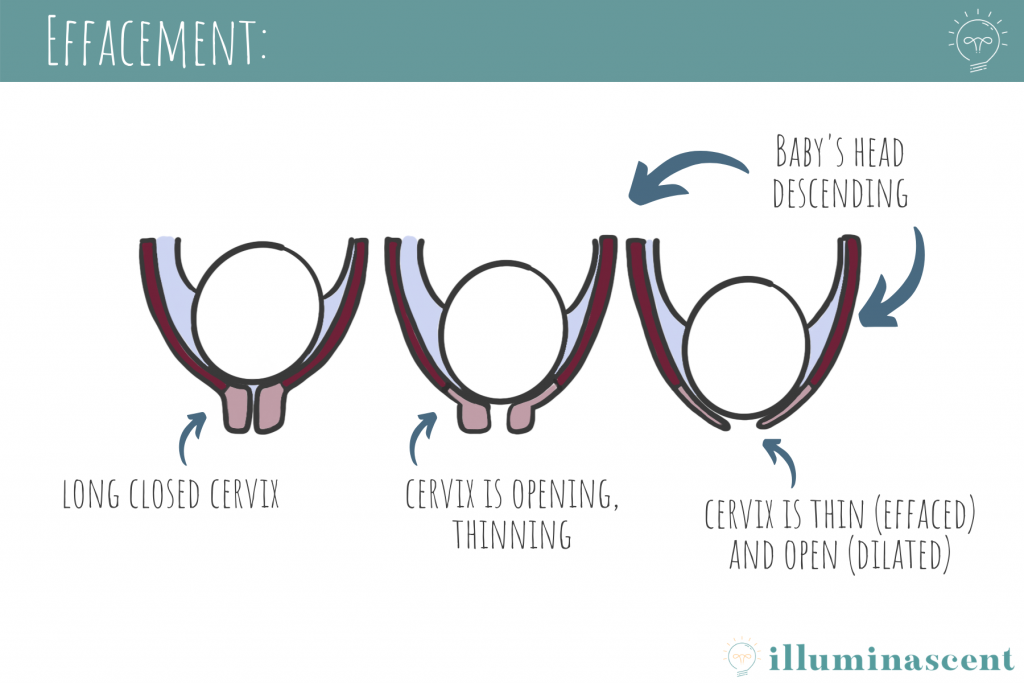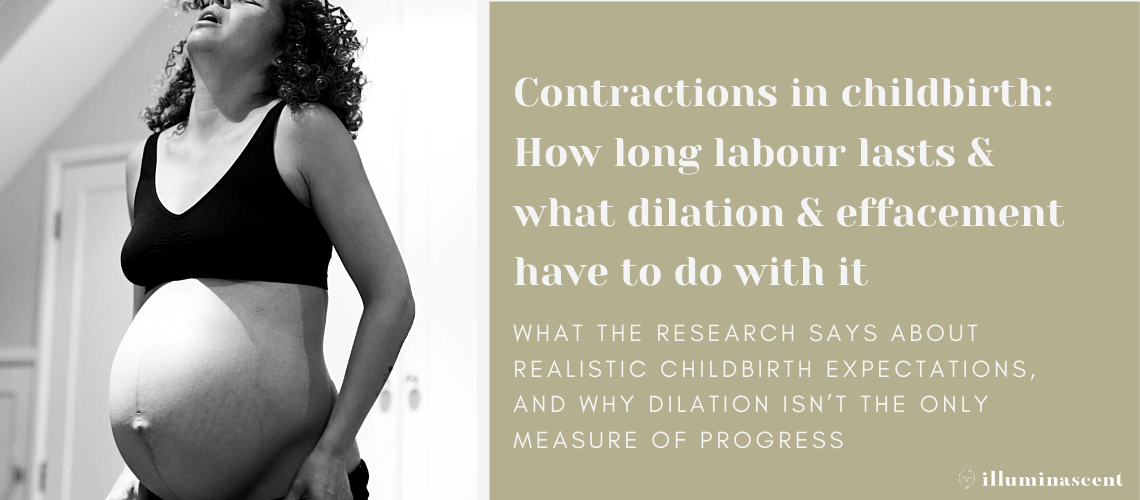Birth stories. They’re all so different, aren’t they? I love reading them and hearing about how babies join their families (and recently I shared one of mine here). When I was pregnant with my first I searched them out to get some sense of what ‘typical’ was when it came to labour – but what does ‘typical’ even mean when it comes to childbirth?
While that may not exist, today we’re going to look at what the research says in terms of the (very large) range of what is normal when it comes to the length of labour. I think this information is so valuable in calibrating expectations to match reality. Chances are you won’t need to immediately rush to the hospital at signs of the first contraction like movies suggest.
What factors can impact the length of labour?
May lengthen:
1. Medical interventions
- An epidural may lengthen both labour1,2 and the pushing phase3
- Having labour medically induced (either by attempting to soften and dilate the cervix locally with synthetic hormones or with a small bulb/balloon, and/or through the use of Pitocin – a synthetic version of oxytocin that causes the uterus to contract)4,5
- Confinement to a bed during labour6
2. Person giving birth
- First birth4,7
- Overweight or obese8-10
- Advanced age (35 years or older)4,11
- Dehydration12
- Survivor of sexual assault13
- Premature rupture of membranes (PROM – when the water breaks before labour starts)4
- A successful external cephalic version for a breech baby (when a healthcare provider puts their hands on the pregnant person’s belly to turn baby into the head-down position)14
- A diagnosis of ‘failure to progress’ during a previous birth15
- Gestational diabetes, high blood pressure or preeclampsia, amniotic fluid levels that are low or high, having had an infant die during/shortly after labour, and infertility treatment4,16
3. Baby
- Positioning of baby (baby’s spine facing the back instead of stomach i.e. ‘sunny-side up’, or baby’s head tilted sideways)17-19
- Big baby (in this study – babies greater than 8 lbs 13 oz or 4000 g)16
- Twins20
May shorten:
1. Medical interventions
- No epidural during labour1-3
- Pitocin augmentation/acceleration (using Pitocin to speed up progress in labour)21
2. Person giving birth
- Have previously given birth4,7
- Upright positions during labor6 and pushing22 (we talk all about this here. Check it out – it’s a good one!)
3. May lengthen, shorten, or not impact anything
- Artificial rupture of membranes (AROM – when a healthcare provider breaks the water)24
How long does it take to fully dilate?

Before we talk numbers, little math term reminder – ‘median’ means the middle number – meaning half of people will take less than the median and half will take more.
Data from a large study published in 2010, including over 62 000 deliveries between 19 hospitals in the US provides some insight.7
There were no multiples in these births, labours all started on their own (no induction), with head-down babies resulting in a vaginal delivery of a healthy baby. About 80% had an epidural (which can slow things down) and 50% were given oxytocin (to speed things up) – so keep that in mind as you read.
- Active labour – which tends to progress more quickly, doesn’t begin until around 6 cm dilation, whether one is a first-timer or not
Early labour (0 – 6 cm):
- Many people (first-timers or not) go long periods without any dilation
- For those arriving at the hospital in labour at 2 cm dilated the median number of hrs is:
- 6 hrs (to go from 2 cm to 6 cm)
- But! On the long end – about 95% will have reached 6 cm by 7 hrs (meaning 5% won’t have – and that’s normal! That 5% who took longer than 15.7 hours still went on to have healthy babies vaginally)
- Also, for some, it can take 7 hrs for those admitted at 2 cm to show any change in dilation (so that means for some, they’ll stay at 2 cm dilated for 7 hrs, and yes, that’s also normal!)
- 6 hrs (to go from 2 cm to 6 cm)
That was a lot of words and information, put more simply, see this visual below:

Active labour (6 cm to 10 cm):
- This is where having had a baby before can speed things up
- To go from 6 cm to 10 cm for first-timers, the median is 2.1 hrs (with 95% of people taking 8.6 hrs or less) and 1.5 hrs for second-timers (with 95% taking 7.5 hrs or less)
Again, let’s see this info visually to get a better grasp:

Pushing phase (10 cm to birth):
- The pushing phase, for those with an epidural, the median is:
- 1.1 hrs for a first-timer, and 0.4 hrs for a second-timer
- Without an epidural, pushing time is decreased:
- 0.6 hrs for a first-timer, 0.2 hrs for a second-timer

Why can it take so long to get to 6 cm?
- Here’s the thing – dilation gets a lot of attention. We seem to measure all progress by dilation, but it’s not the only thing happening
- The cervix also has to soften, shorten and thin out, or ‘efface’, to be able to fully dilate
- Effacement is measured as a percentage and occurs at varying rates with dilation – meaning it can happen at a similar rate to dilation, or can occur a bit ahead of dilation

- So, for those in the study who stayed at 2 cm dilation for 7 hours? That doesn’t mean those contractions weren’t doing anything! Effacement likely increased during that time
- Watch the video below to see how effacement and dilation work together
How long does it take to fully efface?
A 2019 study used records of over 7000 single-baby births from 2010 to 2014 to try to establish the course of effacement in labour as studies looking at effacement are quite limited.25
Somewhat unsurprisingly, researchers found there is a wide range of normal when it comes to how effacement progresses.
That said, they did make a few general conclusions:
- Overall, first-timers were more effaced earlier in their labor when they were less dilated than experienced labourers (meaning the early part of their labour was more about progress in effacement than dilation)
- Similarly, those going into labour on their own (without medical help to start speed up labour) were more effaced at less dilation
- By the time active labour was reached (6 cm dilation), 95% of patients were at least 75% effaced
- Effacement progressed at a gradual rate in all patients, but the rate increased later in labor amongst experienced labourers
Why does this matter?
Picture this. A woman arrives at the hospital in labour. She’s been having somewhat regular contractions for a few hours now and thinks she MUST be getting close to active labour – that magical 6 cm mark. Upon check-in to the hospital, the nurse checks and tells her she’s 2 cm dilated (and likely doesn’t mention it, but notes in her chart that she’s 35% effaced). A little deflated at that 2 cm number, mom tries to push it out of her head and keeps labouring, her contractions consistent and strong over the next few hours. It’s been about 6 hours since contractions started. If you remember from above, half of labourers will take longer than 6 hours, and half will take less, to get to 6 cm. Nurse checks her again, she’s still at 2 cm. She is crushed, discouraged, and doesn’t know how she has been labouring for 6 hours and still sits at 2 cm. Doesn’t understand her 3 hours of hard work at the hospital with no progress. She starts to question if her body is going to do what it needs to do. But we also know that first-timers efface earlier with less dilation. She doesn’t know it, because she hasn’t been told, but she’s now 65% effaced, up from 35% when she arrived. 95% of those in labour will reach 75% by 6 cm. She’s making progress. So maybe after another 90 minutes contractions seem to ramp up and all of a sudden she’s at 6 cm and is 75% effaced, and what seemed like a slow start, was a labour progressing pretty much right on average of what is normal.
What’s the take-home message?
- There are many factors associated with slowing down or speeding up labour
- Labour can last a very long time and still result in a healthy baby born vaginally – 95% will reach active labour (6 cm) by 15.7 hours (and 5% will take longer!)
- It is normal to have no progress in dilation for hours at a time – for some it took 7 hours to show any change in dilation when admitted at 2 cm
- Effacement occurs earlier in labour and with less dilation in first-timers. Since effacement must occur for full dilation to occur, first-timers may be slow to dilate as the cervix first works to thin out
- Regardless, 95% of people will be 75% effaced by the time they reach active labour (6 cm dilation)
References: 1. Alexander et al. 2002; 2. Frigo et al. 2011; 3. Anim-Somuah et al. 2011; 4. Sheiner et al. 2002a; 5. Vahratian et al. 2005; 6. Lawrence et al. 2013; 7. Zhang, Landy et al. 2010; 8. Kominiarek et al. 2011; 9. Carlhall 2013; 10. Kawakita et al. 2016; 11. Timofeev 2013; 12. Dawood et al. 2013; 13. Nerum et al. 2010); 14. Basu et al. 2016; 15. Tobias et al. 2015; 16. Sheiner et al. 2002b; 17. Gardberg & Tuppurainen 1994; 18. Senecal et al. 2005; 19. Malvasi 2015; 20. Leftwich et al. 2013; 21. Bugg et al. 2013; 22. Gupta et al. 2012; 23. Friedman 1955; 24. Smyth et al. 2013; 25. Rhoades et al. 2019
Disclaimer: The information in this post absolutely does not constitute advice from a healthcare professional and is solely intended to provide you with general information. Each person is unique with individual circumstances, and as such some or all information may not apply to you.
This information does not substitute for your healthcare provider’s medical advice and should not be relied upon as such. Before making any decisions, be sure to reach out to a qualified healthcare professional. If you are pregnant and need to be examined, please see a physician, nurse practitioner, midwife or obstetrician.
We strive to ensure that the information provided is accurate, evidence-based, and reliable, but cannot guarantee that it is error-free or complete.

